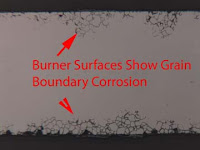
 Corrosion engineer performed a metallurgy failure analysis to determine the cause of prematurely failing burners in a particular brand of gas grill. The burners in question would fail completely after two or three years of service. The failure analysis of the burner revealed that the grill manufacturer made the subject gas burners from an inferior grade of stainless steel. They used a relatively obscure alloy (J1). This alloy is a variation on 304 stainless steel. The 304 alloy contains 18% chromium (Cr), 8% nickel (Ni) and 2% maximum manganese (Mn), and it allows a maximum of 0.08% carbon (C). The J1 alloy allows the same amount of C but contains only 15% Cr; it also has 4% Ni and 8% Mn. Because the Cr is the active ingredient for the corrosion resistence of stainless steel, the J1 alloy will perform poorly in a corrosive environment. A by-product of burning propane in a gas grill is water. In addition, the burner is hot with other contaminants on it; a corrosion expert would state that this is a corrsive environment. Upper left is a photograph of a burner that failed prematurely. Upper right is an unetched metallugraphic sample of a piece of this burner. One can clearly see that the burner surface shows grain bounbary corrosion. It is believed that the low level of Cr and the presence of water and carbon makes the J1 alloy susceptable to stainless steel corrosion and unsuitable for gas grill burners. This product defect analysis indicates that this is a not a manufacturing defect but design defect.
Corrosion engineer performed a metallurgy failure analysis to determine the cause of prematurely failing burners in a particular brand of gas grill. The burners in question would fail completely after two or three years of service. The failure analysis of the burner revealed that the grill manufacturer made the subject gas burners from an inferior grade of stainless steel. They used a relatively obscure alloy (J1). This alloy is a variation on 304 stainless steel. The 304 alloy contains 18% chromium (Cr), 8% nickel (Ni) and 2% maximum manganese (Mn), and it allows a maximum of 0.08% carbon (C). The J1 alloy allows the same amount of C but contains only 15% Cr; it also has 4% Ni and 8% Mn. Because the Cr is the active ingredient for the corrosion resistence of stainless steel, the J1 alloy will perform poorly in a corrosive environment. A by-product of burning propane in a gas grill is water. In addition, the burner is hot with other contaminants on it; a corrosion expert would state that this is a corrsive environment. Upper left is a photograph of a burner that failed prematurely. Upper right is an unetched metallugraphic sample of a piece of this burner. One can clearly see that the burner surface shows grain bounbary corrosion. It is believed that the low level of Cr and the presence of water and carbon makes the J1 alloy susceptable to stainless steel corrosion and unsuitable for gas grill burners. This product defect analysis indicates that this is a not a manufacturing defect but design defect.
Materials Failure Analysis and Process Engineering





Read Consulting Failure Analysis
Thomas L. Read, PhD,
1435 Fulton Road Santa Rosa, CA
Phone: 707-494-5089
email: info@readconsulting.com
Registered Professional Engineer
Thomas L. Read, PhD., CEO
Registered Professional Engineer
Certificate No. MF002174
State of California.